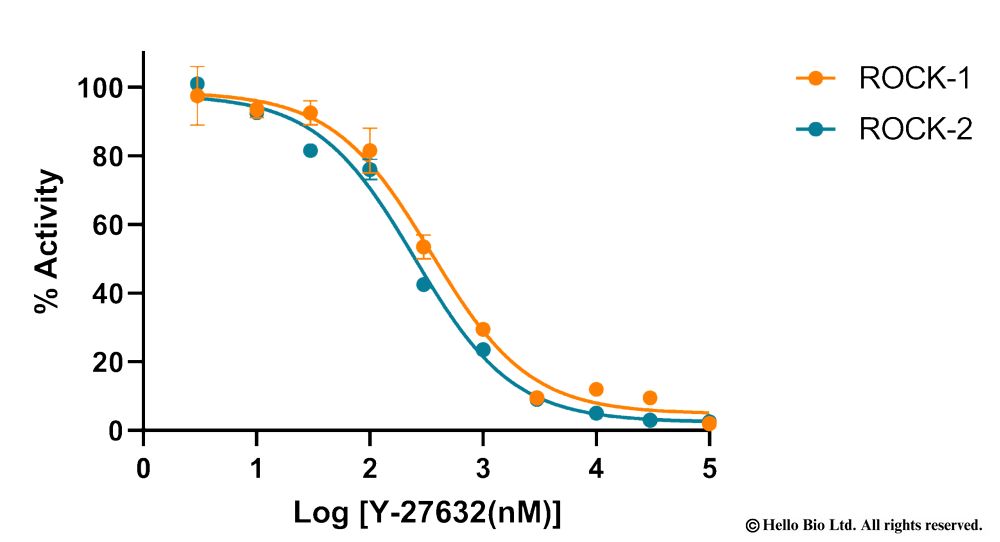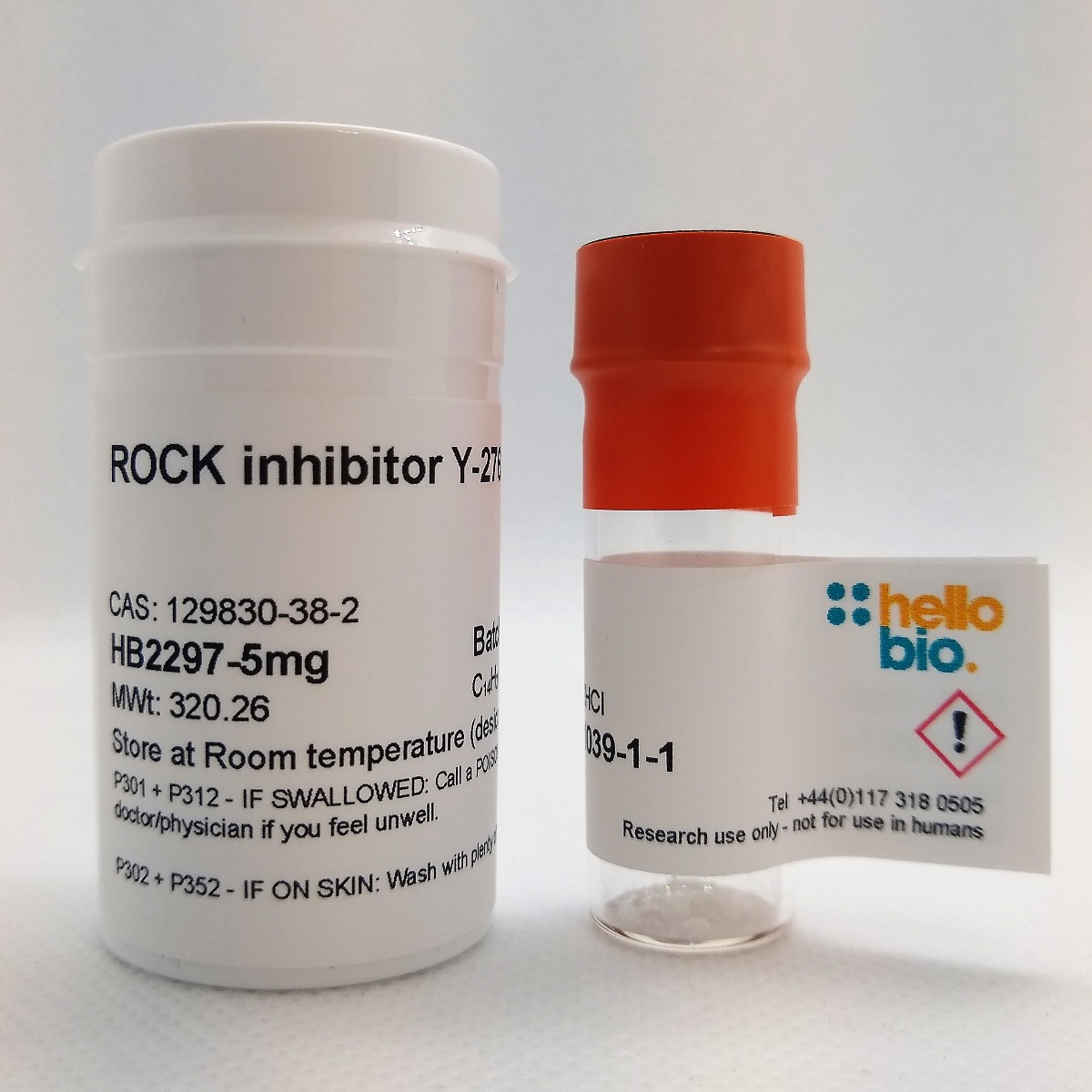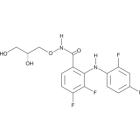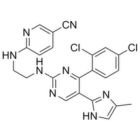ROCK inhibitor Y-27632
Certificate of Analysis
Product overview
| Name | ROCK inhibitor Y-27632 |
| Alternative names | Y27632 dihydrochloride |
| Purity | >99% |
| Customer comments | Works just as intended, at half the price of what it costs at another company. Verified customer, University of Alabama at Birmingham, USA Worked well just as it should do. Kept me informed of when product would be delivered and notified me when delivered. Good packaging and data sheet. Easy to dissolve and use and it worked! Verified customer, University of Cardiff, UK |
| Description | Y-27632 is a selective ROCK inhibitor. Frequently used 3D growth matrix component and for production of organoids. Also used when inducing neurons from fibroblasts. Manufactured to a high degree of optical purity. |
Images
Biological Data
| Biological description | The ROCK inhibitor Y-27632 is a selective and cell permeable inhibitor of the Rho-associated protein kinase (ROCK) (Ki values are 0.14, 26 ,25 and >250 µM at p160ROCK, PKC, PKA and MLCK respectively). Y-27632 has many biological actions and is an important small molecule modulator of stem cells. It diminishes hESC and hiPSC dissociation-induced apoptosis, enhances survival and colony formation of dissociated hESC without affecting pluripotency or self-renewal. Y-27632 also improves hESC and iPSCs postthaw viability and survival rate during cryopreservation. It is frequently used as a 3D growth matrix component and for production of organoids (e.g. brain organoids). Additionally, Y-27632 inhibits smooth muscle contractility and shows antihypertensive effect.
Background Rho kinase (Rho-associated coiled coil protein kinase or ROCK) is a major downstream effector for the small GTP-binding protein Rho [1]. Rho kinase is involved in various biological processes including cell mitosis adhesion, cytoskeletal adjustments, muscle cell contraction, tumor cell invasion and a series of cell biological phenomena [2]. Through a series of cascading effects, Rho kinase influences actin and microtubule regulation of apoptosis and thus plays a key role in early embryonic development [3].The Rho kinase signalling pathway is highly activated in many pathological conditions [4]. Rock inhibitor Y-27632 is a Rho kinase inhibitor which selectively inhibits p160ROCK (ROCK1) with a Ki value of 140 nM and binds to the Rho kinase ATP binding pocket in an ATP-competitive manner [5].
Uses Y-27632 has been shown to have a diverse range of actions and has been used in a variety of biological systems. It is the most commonly used of the ROCK inhibitors in stem cell research and is used as a multifunctional reagent in many stem cell related processes [6]. Y-27632 demonstrates many positive effects across various cell types, in particular human embryonic stem cells (hESCs) and human induced pluripotent stem cells (hiPSCs) [7] and has greatly improved a number of practical stem cell procedures [8]. For example it has been shown that Y-27632 increases cell adhesion and proliferation and increases post-thaw cell survival and post-passaging cell viability [9,10].
Cellular dissociation Cell dissociation is one of the most common manipulations in stem cell research. During cellular dissociation both hESC and hIPSCs are vulnerable to dissociation-induced apoptosis or anoikis (a form of apoptosis induced by inappropriate cell-cell or cell-ECM interactions) [3,11]. Y-27632 is of particular interest as it allows hPSCs to escape this dissociation-induced apoptosis. Y-27632 prevents apoptosis of dissociated hPSCs and increases their survival rate and plating efficiency [11].
Cryopreservation Cryopreservation is also an important part of stem cell research. Y-27632 improves the recovery of cryopreserved hPSCs and has greatly helped simplify the cryopreservation procedure. The slow-freezing and rapid-thawing procedure which uses DMSO as a cryoprotectant is commonly used in stem cell cryopreservation, however this method is not suitable for hPSCs, therefore vitrification (fast freezing, slow thawing) is used [12]. Vitrified hPSCs do however still suffer from high levels of cell death and do not passage well as single cells [11]. The addition of Y-27632 to freezing and post-thawing medium enhances colony formation efficiency and treatment with Y-27632 during cryopreservation also increases survival rate and cell adhesion of freeze-thawed dissociated hES [12].
|
| Application notes | #Protocol 1: ROCK Inhibition assay using Y-27632
|
Solubility & Handling
| Solubility overview | Soluble in water (100mM), PBS (100mM), DMSO (100mM) |
| Storage instructions | Room temperature (desiccate) |
| Storage of solutions | Prepare and use solutions on the same day if possible. Store solutions at -20°C for up to one month if storage is required. Equilibrate to RT and ensure the solution is precipitate free before use. |
| Handling |
|
| Shipping Conditions | Stable for ambient temperature shipping. Follow storage instructions on receipt. |
| Important | This product is for RESEARCH USE ONLY and is not intended for therapeutic or diagnostic use. Not for human or veterinary use. |
Chemical Data
| Purity | >99% |
| Chemical name | trans-4-[(1R)-1-Aminoethyl]-N-4-pyridinylcyclohexanecarboxamide dihydrochloride |
| Molecular Weight | 320.26 |
| Chemical structure | ![Y-27632 dihydrochloride [129830-38-2] Y-27632 dihydrochloride [129830-38-2] Chemical Structure](https://cdn.hellobio.com/media/catalog/product//h/b/hb2297.png) |
| Molecular Formula | C14H21N3O.2HCl |
| CAS Number | 129830-38-2 |
| PubChem identifier | 9901617 |
| SMILES | C[C@H](C1CCC(CC1)C(=O)NC2=CC=NC=C2)N.Cl.Cl |
| Source | Synthetic |
| InChi | InChI=1S/C14H21N3O.2ClH/c1-10(15)11-2-4-12(5-3-11)14(18)17-13-6-8-16-9-7-13;;/h6-12H,2-5,15H2,1H3,(H,16,17,18);2*1H/t10-,11?,12?;;/m1../s1 |
| InChiKey | IDDDVXIUIXWAGJ-DDSAHXNVSA-N |
| MDL number | MFCD03490488 |
| Appearance | White solid |
References for ROCK inhibitor Y-27632
-
11, Application of Rho-associated protein kinase (ROCK) inhibitor to human pluripotent stem cells.
Kurosawa (2012) J Biosci Bioeng. 114(6) : 577-81 -
1, Rho-kinase/ROCK: A key regulator of the cytoskeleton and cell polarity.
Amano et al (2010) Cytoskeleton (Hoboken) 67(9) : 545-54 -
8,Molecular pathway and cell state responsible for dissociation-induced apoptosis in human pluripotent stem cells.
Ohgushi et al (2010) Cell Stem Cell 7(2) : 225-39 -
12, Novel cryopreservation method for dissociated human embryonic stem cells in the presence of a ROCK inhibitor.
Martin-Ibañez et al (2008) Hum Reprod. 23(12) : 2744-54 -
7, A ROCK inhibitor permits survival of dissociated human embryonic stem cells.
Wanatabe et al (2007) Nat Biotechnol 25(6) : 681-6
-
HiPSC-derived 3D neural models reveal neurodevelopmental pathomechanisms of the Cockayne Syndrome B.
Kapr J et al (2024) Cellular and molecular life sciences : CMLS 81 : 368PubMedID: 39179905 -
Molecular and Functional Characterization of Different BrainSphere Models for Use in Neurotoxicity Testing on Microelectrode Arrays.
Hartmann J et al (2023) Cells 12PubMedID: 37174670 -
Molecular and Functional Characterization of Different BrainSphere Models for Use in Neurotoxicity Testing on Microelectrode Arrays.
Hartmann J et al (2023) Cells 12PubMedID: 37174670 -
Aerosol Jet-Printed High-Aspect Ratio Micro-Needle Electrode Arrays Applied for Human Cerebral Organoids and 3D Neurospheroid Networks.
Zips S et al (2023) ACS applied materials & interfaces 15 : 35950-35961PubMedID: 37469180 -
Targeted mechanical stimulation via magnetic nanoparticles guides in vitro tissue development.
Abdel Fattah AR et al (2023) Nature communications 14 : 5281PubMedID: 37644160








 Understanding purity and quality - a guide for life scientists
Understanding purity and quality - a guide for life scientists

